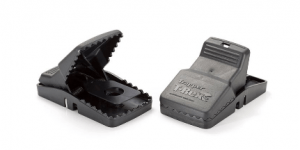An integrated pest management (IPM) program is an important part of every food facility’s effort to produce a safe, legal food product. Certain insects, rodents, and birds are capable of introducing significant contamination issues into a food plant. Every effort must be made to minimize the risks posed by these pests.
IPM is a comprehensive approach to pest population management that considers several strategies to eliminate or reduce a pest population to tolerable levels while enhancing the quality of the environment. To do this, the IPM program relies on your knowledge of the biology and behavior of the specific pest population to determine which factors are allowing pests to enter and supporting their ability to survive and increase in numbers.
A well-managed IPM program requires a combination of strategies to be successful. There are no magic bullets or one-size-fits-all programs. Every food plant and every pest issue is unique and influenced by the conditions present. A true professional understands this and uses the information to establish a successful IPM program. The core elements of an Integrated Pest Management program are:
- Knowing the pest’s biology and behavior
- Problem-solving using the ICE principle
- Understanding and using prerequisite programs to control or change the environment supporting the pest population
- Implementing a correct and effective monitoring program
- Collecting and establishing trends from the data available
- Educating employees
- Using pesticides only when needed
ICE principle
The ICE principle is a problem-solving strategy that has several applications in a food plant.
I = Identify, introduce, intensify
C = Control
E = Eliminate
Identify, introduce, intensify
The entire facility has to be inspected inside and out to determine the presence of a pest population and how significant it is concerning the integrity of the products being produced. Using information about the pest’s biology and behavior, a determination can be made about the level of infestation and possible entry points that pests use to access the facility. By knowing that not every stored product insect or rodent comes in with ingredients, but can originate outside of a facility and gain access through doors, windows, or other openings, you can significantly expand your area of concern when an issue is identified.
Control
If an issue is discovered, the next step is to determine immediate steps that need to be taken to avoid the potential adulteration of food products. A short-term corrective action is not a complete solution to the problem.
Eliminate
The goal of this step is to identify a long-term corrective action that will prevent and/or eliminate the issue from reoccurring. Typically, a program that needs to be modified or adjusted to prevent recurrence or eliminate the problem will be identified. The collection of flour and insect activity in the example are indicators of a failure of the programs and procedures designed to prevent this from happening. Cleaning will not resolve the issue unless the root cause for the presence of flour and insects is identified and eliminated. This principle applies to managing any pest issue.
Monitoring
Active and passive monitoring systems are important elements of an Integrated Pest Management program.
Routine assessments and internal inspection programs are great active monitoring tools. They provide an extremely important facility snapshot. They provide the opportunity to observe a pest issue discovered during the inspection, implement corrective action, and move toward eliminating the root causes.
One of the limitations of these programs is that you will only see what is physically there at that moment in time. Implementing a passive monitoring program using devices that will be in place for extended periods of time will provide an opportunity to collect information over a period of time when you are not physically present. Mechanical rodent control devices, pheromone traps, glue boards, insect light traps, etc. are a few of the tools available to place into an environment to collect information 24/7.

The key to using monitoring devices is understanding where to place them, and more importantly, understanding the information they are providing. For example, determining the age and sex of mice caught in glue boards can provide information about population growth, how close the boards are to the actual nesting sites, and sometimes the direction they came from. Young males on the glue board would indicate an expanding population because they are exploring new territories, as would the presence of pregnant females. There is typically a 1:1 ratio of males to females. If a higher number of one gender is being caught, it could mean the females have recently had litters and are confined to the nest to care for their young.
The same can be said about insect light traps. It is not the number of insects captured, but the species. Capturing a large number of exterior flying insects indicates that the building is compromised (e.g., doors left open or a structural defect), but finding stored product insects in light traps is a likely indicator of infested material somewhere nearby.
Trending
Trending data collected through monitoring systems should be a requirement of a well-managed IPM program. Collecting data, but never analyzing it is not a good use of information. The information from the monitoring system provides details about what is currently happening, as well as a historical view of your program and potential trouble spots.
More often than not, the 80/20 rule applies to pest management. Frequently 80% of pest issues occur in roughly 20% of the facility. Use the data collected to identify and map the area of concern and focus efforts in those locations. Not only is this approach effective, but also more efficient, resulting in cost savings for your company.
Data needed for the trend analysis comes from pest management service records, pest sighting logs, and inspections conducted by service technicians or plant personnel during monthly plant inspections. The facility must react to the information from the trending analysis and investigate to find a solution. Often the solution is not a pesticide application, but rather a correction of a structural or sanitation issue. Permanently closing the gap in the floor where insects are breeding is a far better solution than injecting pesticides every week.
Data can be presented in many different ways. The use of charts and graphs often has a much higher impact on people reviewing data. Several software programs can assist in designing data for presentation and shorten the administrative time to produce reports and achieve results.
However, make sure someone who understands the significance of the data is looking at the reports and data so that opportunities and issues do not go unnoticed.
Implementing an IPM Program
A well-defined and documented IPM program with a defined scope and objectives is essential. The written program must incorporate key elements of the prerequisite programs that impact actual or potential pest issues. The program defines the responsibilities of the plant and contracted services if they are used. If internal personnel is used, the program outlines the structure of the program and the knowledge and skills they need to effectively complete IPM tasks.
Before accepting a contract or implementing an IPM program for a facility, trained personnel should conduct a very detailed assessment of the current conditions of the structure and levels of pest activity. Those conducting the assessment need pest management knowledge and an understanding of the processes conducted by the food plant. The assessment provides a thorough inspection and evaluation of every area of the facility. What happens on the plant grounds and adjacent properties will impact the program? Conditions on the roof can play a major role if they are a source of attraction and a way to access the facility. Every aspect of the inside of the facility from the ceiling to the basement and all equipment and materials in these areas is subject to inspection. You cannot truly determine IPM program needs until this has been done and is well documented.
Source: AIB

